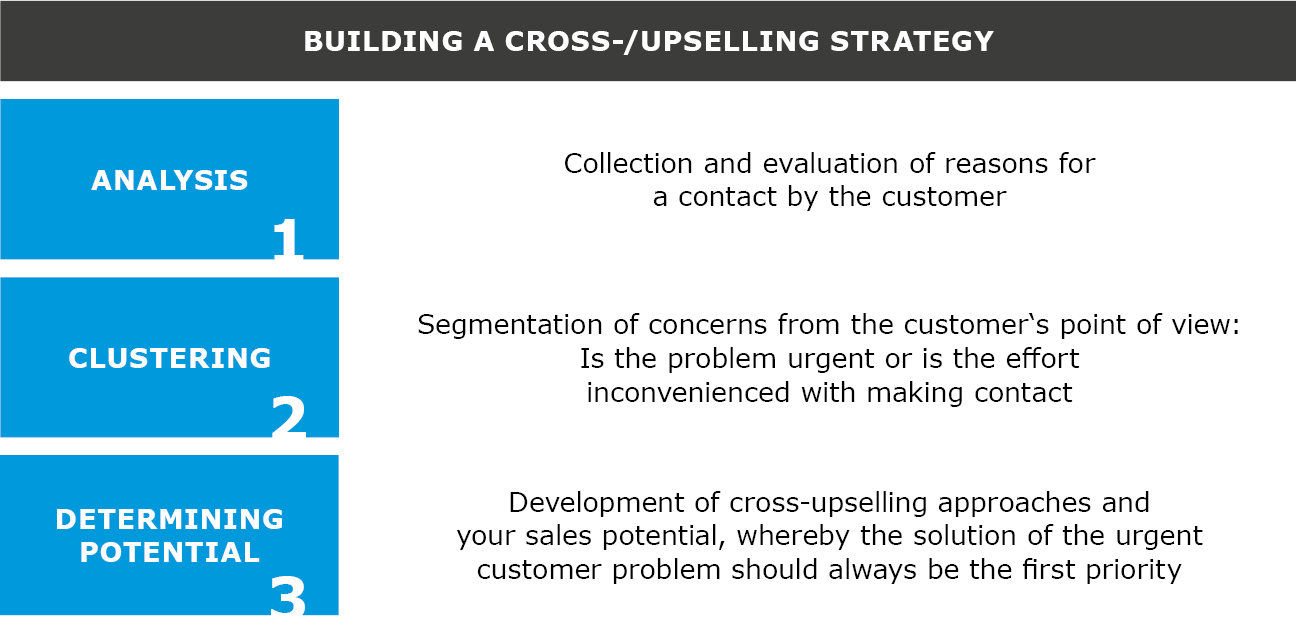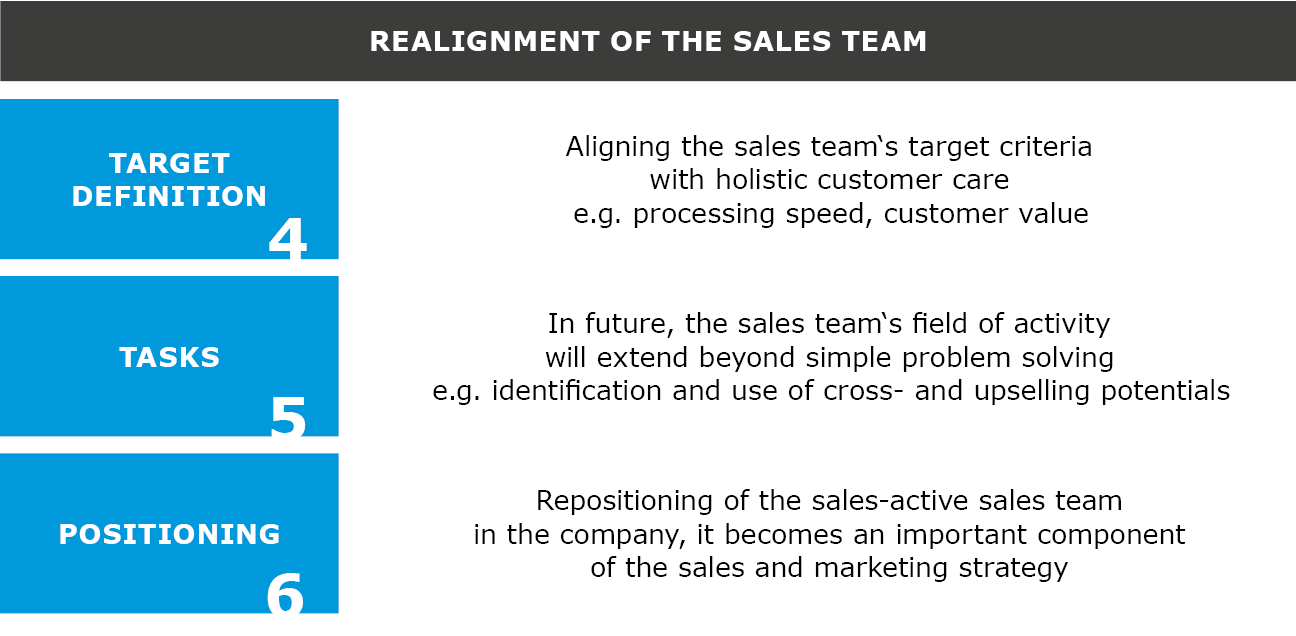
Who wants to bring his sales in B2B sales to the top should not only eye more new customers but also intensively work on his existing customers. Find out here how you can optimally utilise the sales potentials of existing customers through strategic cross and upselling, how you can proceed best, and which effects this has on your sales and customer satisfaction.
You know this: If you want to increase the sales of your company with your team, you generally have two options. Firstly, acquire new customers. Secondly, increase sales with your existing customers. In sales practice, you will of course combine both options. Of course, your team has to acquire new customers.
But are you sure that your team really taps and utilises the potential of your existing customers systematically? This is frequently where more earnings can be found than your sales staff suspects. Moreover, acquiring a new customer often costs multiples of what you have to invest to get the additional sales from an existing customer.
Cross-Selling is a sales strategy where you sell your customer an additional product or further service from your portfolio, which matches the products and services he has previously chosen or purchased. According to the principle: “Would you like some more?” Or like the encouraging information given in online shops: “Customers who have purchased x, also purchased y.” Examples of this from B2B sales are:
Your offer of complementing products or services simplifies the purchasing process for the customer while it simultaneously has the potential of raising your sales revenue.
Upselling as a sales strategy is proposing the better, newer product of the same category to an existing customer. Or the sales staff offers upgrades. In a private setting, you may have already seen this in an offer of a larger rental car than the one booked or a better room category in the hotel against an additional charge.
Examples of this from B2B sales are:
If you would like to generate a maximum in sales, you should be sure to offer your customer upsell options.
Acquiring new customers is an expensive as time-consuming endeavour for a company. Therefore, increasing value is placed in sales organisations on a cleverly devised account management system. Existing customers frequently have the potential of generating additional sales. So, give existing customers what they deserve: attention, time and a solution-oriented consultation.
Dealing with your customers and your product portfolio in depth is a prerequisite for increasing sales in your existing customer segment significantly and lastingly by means of cross and upselling. To make use of sales opportunities in each customer contact, you need in-depth knowledge of the problems, tasks and expectations of your customers. You should also understand how exactly you can help your customers with your products.
The consequence: Your customers feel appreciated when you offer the right approaches to solutions at the right time!
You will reach better conversion rates and increase your bottom line with additional sales. The smart use of cross and upselling furthermore not only improves the customer value but also customer satisfaction.
For the SUXXEED expert and sales director, Miguel Matos, it is therefore not comprehensible why many companies in B2B sales today still strongly neglect cross and upselling:
Those who do not see to cross and upselling systematically lose important sales with existing customers!
Miguel Matos
Sales Director
To identify the cross and upselling potential of your B2B customers, it is best to start a thorough analysis with your team.
The following questions can help you in the analysis of potentials:
In your analysis, go by customer segments or customer groups to derive commonalities. Based on these, develop a cross and upselling guideline for daily practice for each individual customer together with your contact centre actively promoting sales or inside sales team.
The following tips can help you fully use your sales potential through cross-selling and upselling with your existing customers:
The basic condition for successful cross-selling is a well-functioning customer relationship. To be able to enrich this customer relationship, a regular dialogue with the customer is needed and a committed and reliable handling of the customer’s interests. Moreover, you and your team should think carefully about which products can be sold together and complement each other.
Tip: The better you know the customer and his needs, the easier it will be for you to successfully operate cross-selling.
In contact with a customer, a sales employee finds out that the single workstation printers at the customer’s company are from different manufacturers. This repeatedly leads to problems and time pressure because the respectively needed toners are often not in stock at the moment. Therefore, the inside sales employee suggests installing centralised printers for each floor. This resolves the toner problem on the one hand. And on the other hand, the centralised devices save time and space, and they offer better printing results than the older single workstation models.
For upselling, as well, you and your team have to be sufficiently informed about the customer and the industry, meaning the market, novelties, and competitors. Show your customer a vision of how he will invest in the future of his business with the improvement and how a ROI realises quickly this way.
If the, a sales meeting with upselling opportunity takes place, your inside sales employee should of course name a price at the appropriate point, which should be perceived by no means as too high by the customer. Best, your employee talks about an “investment,” as this term implies that the customer will get something in return for his money. However, when the preparation has been good, the purchase decision cannot even fail for the price because the customer’s pain has been identified correctly ahead of time.
Tip: Find the customer’s pain and pay attention that the higher value solution, the upselling product, offers a true added value for the customer. Otherwise, it will soon turn into “overselling” where you want to sell more than the customer needs or where you promise more than the product can perform – a breach of trust that can lead to the loss of the customer!
For a dairy farmer with 60 cows, it is not easy to keep an eye on all his animals on 6,000 hectares of pastures. The task was clear therefore: The farmer wanted to know where his cows are at what time exactly. By introducing a cow monitoring software, this requirement was covered.
But this not only provided security for the farmer and saved him lots of working time, it additionally covered all critical data points with insight into the health and nutrition of the cow. The sales representative was optimally prepared for an upselling opportunity only by his attentive listening and prior research at an agricultural trade fair.
In B2B sales, numerous opportunities and occasions are offered that your team can use for cross and upselling. Depending on which point in your organisation your customer contacts, you should have different processes defined that you can use to realise sales opportunities. Other than inside sales, such points of contact can also be, for example, your service or technology team.
The following overview shows some examples of customer situations that you can use in the definition of your cross and upselling strategy.
Cross-selling and upselling is conducted nowadays by any sales unit. This is a task for the key account manager, outside sales representative, partner account manager, inside sales employee or office staffer and technician. It is therefore important to draft a strategic concept for the parties involved, which defines the process in detail.
The following graphic helps you draft your cross and upselling concept in 6 steps:


Whether you structure or expand a systematic cross-selling and upselling model in your B2B sales organisation yourself or assign an external sales service provider with this task essentially depends on the following questions:
Especially companies with a large existing customer base have difficulties utilising their cross and upselling potential on their own with their existing team. Here, the support from an external contact centre actively promoting sales or an actively selling outsourced inside sales team get your B2B sales organisation far ahead.
You will have the right employees at the starting line with your sales service provider. You will profit from the experience of your project manager in analysis, strategy definition and implementation. And your outsourced inside sales team will soon get additional sales from your existing customers and relieve your outside sales force.